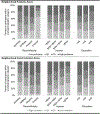Neighborhood Social Context and Kidney Function Over Time: The Multi-Ethnic Study of Atherosclerosis
- PMID: 30655114
- PMCID: PMC6594400
- DOI: 10.1053/j.ajkd.2018.10.015
Neighborhood Social Context and Kidney Function Over Time: The Multi-Ethnic Study of Atherosclerosis
Abstract
Rationale & objective: Although socioeconomic status has been associated with chronic kidney disease (CKD), little is known about its relationship to residential neighborhood context.
Study design: Secondary analysis of the Multi-Ethnic Study of Atherosclerosis (MESA), a prospective cohort study designed to investigate the development and progression of subclinical cardiovascular disease.
Setting & participants: 6,814 men and women who were between 45 and 84 years of age and free of cardiovascular disease were recruited between 2000 and 2002 from Baltimore, MD; Chicago, IL; Forsyth County, NC; Los Angeles, CA; New York, NY; and St. Paul, MN.
Exposures: A composite neighborhood problem score (calculated based on 7 participant-reported domains at study entry: adequacy of food sources, availability of parks/playground, noise, sidewalks, traffic, trash and litter, and violence) and a social cohesion score (calculated based on 5 participant-reported attributes of people in their neighborhood: close knit; get along; willing to help neighbors; trustworthy; and share values).
Outcomes: Estimated glomerular filtration rate (eGFR; calculated using the CKD-EPI [CKD Epidemiology Collaboration] creatinine-cystatin C equation) and an indicator of eGFR decline > 30% since study entry using follow-up eGFR quantified at 4 examinations: 2000 to 2002, 2004 to 2005, 2005 to 2007, and 2010 to 2011.
Analytical approach: Associations between each neighborhood measure (in separate models) and eGFR decline > 30% from baseline and annualized eGFR change were estimated using Cox proportional hazards and linear mixed regression models, respectively, adjusting for potential confounders.
Results: While neighborhood social context differs by race/ethnicity, neither neighborhood problems nor social cohesion was independently associated with eGFR decline after adjustment for confounders.
Limitations: Incomplete capture of the early stages of eGFR decline, reliance on observational data, limited variation in neighborhood measures, and the potential for residual confounding.
Conclusions: Although we showed no independent association between neighborhood context and eGFR decline, it is associated with many CKD risk factors and further work is needed to clarify whether it has an independent role in CKD.
Keywords: Chronic kidney diseases; eGFR decline; estimated glomerular filtration rate (eGFR); health disparities; kidney function; modifiable risk factor; neighborhood; neighborhood problems; residential setting; social cohesion; socioeconomic status (SES).
Copyright © 2018 National Kidney Foundation, Inc. Published by Elsevier Inc. All rights reserved.
Conflict of interest statement
Financial Disclosure: The authors declare that they have no relevant financial interests.
Figures
Comment in
-
CKD Progression: Teasing Out Contributions of Elements in the Human Exposome.Am J Kidney Dis. 2019 May;73(5):581-582. doi: 10.1053/j.ajkd.2019.01.018. Epub 2019 Mar 12. Am J Kidney Dis. 2019. PMID: 30876748 No abstract available.
References
-
- Diez Roux AV, Mair C. Neighborhoods and health. Ann N Y Acad Sci. 2010;1186:125–145. - PubMed
Publication types
MeSH terms
Grants and funding
- HHSN268201500003C/HL/NHLBI NIH HHS/United States
- N01 HC095161/HL/NHLBI NIH HHS/United States
- N01 HC095168/HL/NHLBI NIH HHS/United States
- N01 HC095161/HC/NHLBI NIH HHS/United States
- N01 HC095164/HC/NHLBI NIH HHS/United States
- N01 HC095167/HL/NHLBI NIH HHS/United States
- N01 HC095159/HL/NHLBI NIH HHS/United States
- UL1 TR001420/TR/NCATS NIH HHS/United States
- N01 HC095163/HL/NHLBI NIH HHS/United States
- HHSN268201500003I/HL/NHLBI NIH HHS/United States
- UL1 TR000040/TR/NCATS NIH HHS/United States
- N01 HC095162/HL/NHLBI NIH HHS/United States
- UL1 TR001079/TR/NCATS NIH HHS/United States
- N01 HC095169/HL/NHLBI NIH HHS/United States
- K01 DK106322/DK/NIDDK NIH HHS/United States
- N01 HC095166/HC/NHLBI NIH HHS/United States
- N01 HC095160/HC/NHLBI NIH HHS/United States
- N01 HC095166/HL/NHLBI NIH HHS/United States
- N01 HC095163/HC/NHLBI NIH HHS/United States
- N01 HC095162/HC/NHLBI NIH HHS/United States
- N01 HC095165/HL/NHLBI NIH HHS/United States
- N01 HC095164/HL/NHLBI NIH HHS/United States
- N01 HC095159/HC/NHLBI NIH HHS/United States
- N01 HC095160/HL/NHLBI NIH HHS/United States
LinkOut - more resources
Full Text Sources
Medical
Research Materials
Miscellaneous


